Timo Gerkmann
Department of Informatics, University of Hamburg, Hamburg, Germany
Real-Time Streaming Mel Vocoding with Generative Flow Matching
Sep 18, 2025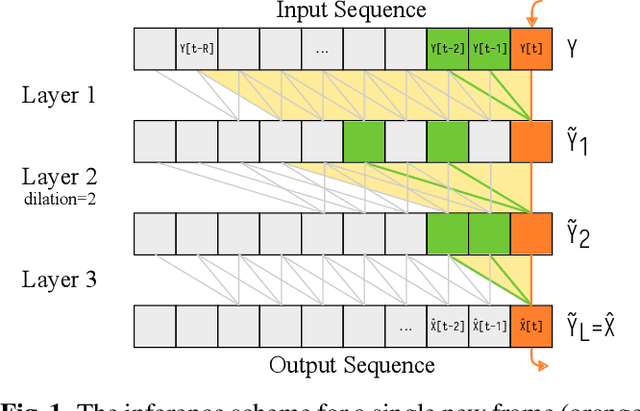
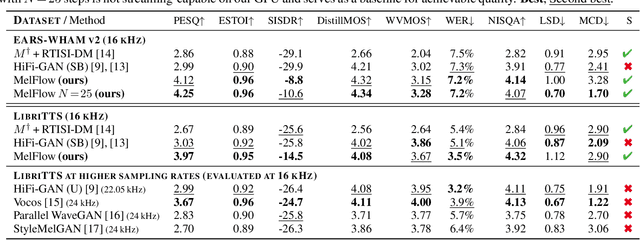

Abstract:The task of Mel vocoding, i.e., the inversion of a Mel magnitude spectrogram to an audio waveform, is still a key component in many text-to-speech (TTS) systems today. Based on generative flow matching, our prior work on generative STFT phase retrieval (DiffPhase), and the pseudoinverse operator of the Mel filterbank, we develop MelFlow, a streaming-capable generative Mel vocoder for speech sampled at 16 kHz with an algorithmic latency of only 32 ms and a total latency of 48 ms. We show real-time streaming capability at this latency not only in theory, but in practice on a consumer laptop GPU. Furthermore, we show that our model achieves substantially better PESQ and SI-SDR values compared to well-established not streaming-capable baselines for Mel vocoding including HiFi-GAN.
Self-Steering Deep Non-Linear Spatially Selective Filters for Efficient Extraction of Moving Speakers under Weak Guidance
Jul 03, 2025Abstract:Recent works on deep non-linear spatially selective filters demonstrate exceptional enhancement performance with computationally lightweight architectures for stationary speakers of known directions. However, to maintain this performance in dynamic scenarios, resource-intensive data-driven tracking algorithms become necessary to provide precise spatial guidance conditioned on the initial direction of a target speaker. As this additional computational overhead hinders application in resource-constrained scenarios such as real-time speech enhancement, we present a novel strategy utilizing a low-complexity tracking algorithm in the form of a particle filter instead. Assuming a causal, sequential processing style, we introduce temporal feedback to leverage the enhanced speech signal of the spatially selective filter to compensate for the limited modeling capabilities of the particle filter. Evaluation on a synthetic dataset illustrates how the autoregressive interplay between both algorithms drastically improves tracking accuracy and leads to strong enhancement performance. A listening test with real-world recordings complements these findings by indicating a clear trend towards our proposed self-steering pipeline as preferred choice over comparable methods.
ReverbFX: A Dataset of Room Impulse Responses Derived from Reverb Effect Plugins for Singing Voice Dereverberation
May 26, 2025Abstract:We present ReverbFX, a new room impulse response (RIR) dataset designed for singing voice dereverberation research. Unlike existing datasets based on real recorded RIRs, ReverbFX features a diverse collection of RIRs captured from various reverb audio effect plugins commonly used in music production. We conduct comprehensive experiments using the proposed dataset to benchmark the challenge of dereverberation of singing voice recordings affected by artificial reverbs. We train two state-of-the-art generative models using ReverbFX and demonstrate that models trained with plugin-derived RIRs outperform those trained on realistic RIRs in artificial reverb scenarios.
Steering Deep Non-Linear Spatially Selective Filters for Weakly Guided Extraction of Moving Speakers in Dynamic Scenarios
May 20, 2025Abstract:Recent speaker extraction methods using deep non-linear spatial filtering perform exceptionally well when the target direction is known and stationary. However, spatially dynamic scenarios are considerably more challenging due to time-varying spatial features and arising ambiguities, e.g. when moving speakers cross. While in a static scenario it may be easy for a user to point to the target's direction, manually tracking a moving speaker is impractical. Instead of relying on accurate time-dependent directional cues, which we refer to as strong guidance, in this paper we propose a weakly guided extraction method solely depending on the target's initial position to cope with spatial dynamic scenarios. By incorporating our own deep tracking algorithm and developing a joint training strategy on a synthetic dataset, we demonstrate the proficiency of our approach in resolving spatial ambiguities and even outperform a mismatched, but strongly guided extraction method.
Normalize Everything: A Preconditioned Magnitude-Preserving Architecture for Diffusion-Based Speech Enhancement
May 08, 2025Abstract:This paper presents a new framework for diffusion-based speech enhancement. Our method employs a Schroedinger bridge to transform the noisy speech distribution into the clean speech distribution. To stabilize and improve training, we employ time-dependent scalings of the inputs and outputs of the network, known as preconditioning. We consider two skip connection configurations, which either include or omit the current process state in the denoiser's output, enabling the network to predict either environmental noise or clean speech. Each approach leads to improved performance on different speech enhancement metrics. To maintain stable magnitude levels and balance during training, we use a magnitude-preserving network architecture that normalizes all activations and network weights to unit length. Additionally, we propose learning the contribution of the noisy input within each network block for effective input conditioning. After training, we apply a method to approximate different exponential moving average (EMA) profiles and investigate their effects on the speech enhancement performance. In contrast to image generation tasks, where longer EMA lengths often enhance mode coverage, we observe that shorter EMA lengths consistently lead to better performance on standard speech enhancement metrics. Code, audio examples, and checkpoints are available online.
FlowDec: A flow-based full-band general audio codec with high perceptual quality
Mar 03, 2025Abstract:We propose FlowDec, a neural full-band audio codec for general audio sampled at 48 kHz that combines non-adversarial codec training with a stochastic postfilter based on a novel conditional flow matching method. Compared to the prior work ScoreDec which is based on score matching, we generalize from speech to general audio and move from 24 kbit/s to as low as 4 kbit/s, while improving output quality and reducing the required postfilter DNN evaluations from 60 to 6 without any fine-tuning or distillation techniques. We provide theoretical insights and geometric intuitions for our approach in comparison to ScoreDec as well as another recent work that uses flow matching, and conduct ablation studies on our proposed components. We show that FlowDec is a competitive alternative to the recent GAN-dominated stream of neural codecs, achieving FAD scores better than those of the established GAN-based codec DAC and listening test scores that are on par, and producing qualitatively more natural reconstructions for speech and harmonic structures in music.
Mask-Weighted Spatial Likelihood Coding for Speaker-Independent Joint Localization and Mask Estimation
Oct 25, 2024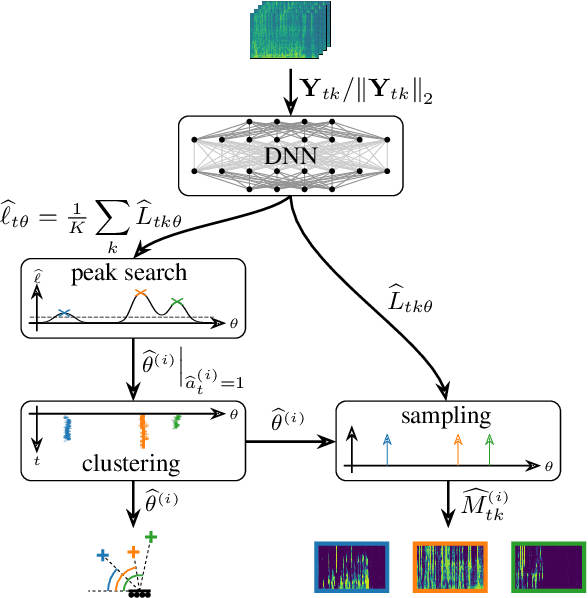

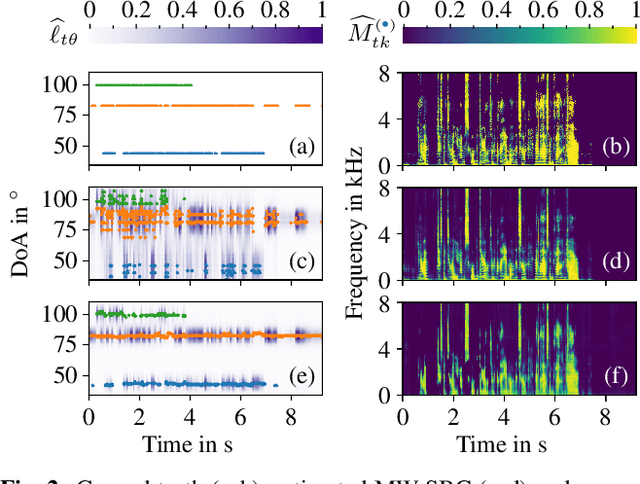
Abstract:Due to their robustness and flexibility, neural-driven beamformers are a popular choice for speech separation in challenging environments with a varying amount of simultaneous speakers alongside noise and reverberation. Time-frequency masks and relative directions of the speakers regarding a fixed spatial grid can be used to estimate the beamformer's parameters. To some degree, speaker-independence is achieved by ensuring a greater amount of spatial partitions than speech sources. In this work, we analyze how to encode both mask and positioning into such a grid to enable joint estimation of both quantities. We propose mask-weighted spatial likelihood coding and show that it achieves considerable performance in both tasks compared to baseline encodings optimized for either localization or mask estimation. In the same setup, we demonstrate superiority for joint estimation of both quantities. Conclusively, we propose a universal approach which can replace an upstream sound source localization system solely by adapting the training framework, making it highly relevant in performance-critical scenarios.
Non-intrusive Speech Quality Assessment with Diffusion Models Trained on Clean Speech
Oct 23, 2024



Abstract:Diffusion models have found great success in generating high quality, natural samples of speech, but their potential for density estimation for speech has so far remained largely unexplored. In this work, we leverage an unconditional diffusion model trained only on clean speech for the assessment of speech quality. We show that the quality of a speech utterance can be assessed by estimating the likelihood of a corresponding sample in the terminating Gaussian distribution, obtained via a deterministic noising process. The resulting method is purely unsupervised, trained only on clean speech, and therefore does not rely on annotations. Our diffusion-based approach leverages clean speech priors to assess quality based on how the input relates to the learned distribution of clean data. Our proposed log-likelihoods show promising results, correlating well with intrusive speech quality metrics such as POLQA and SI-SDR.
HRTF Estimation using a Score-based Prior
Oct 02, 2024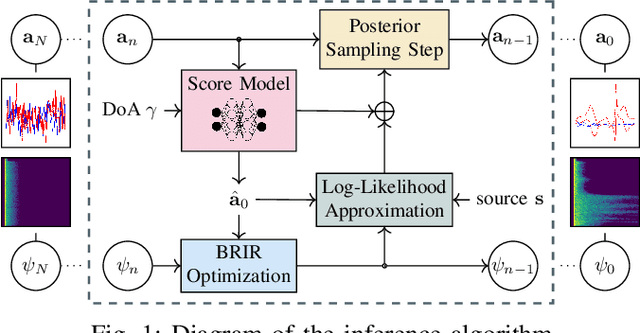
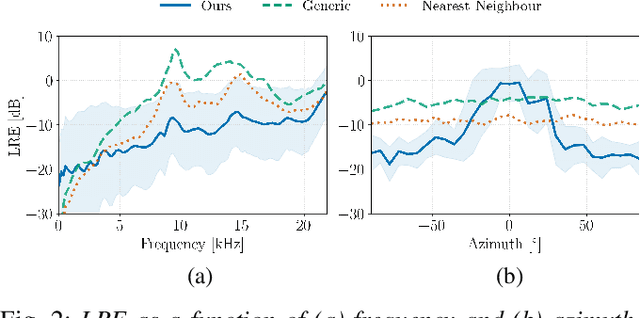
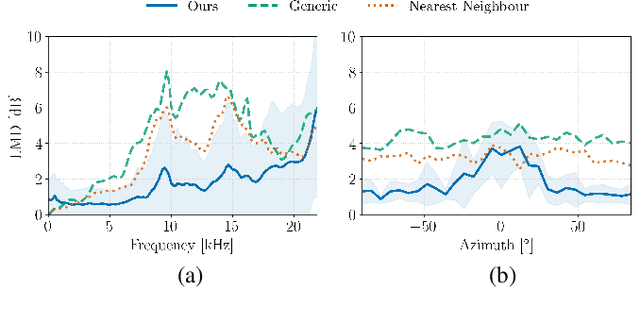
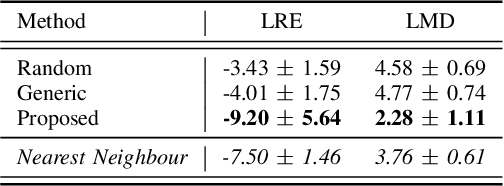
Abstract:We present a head-related transfer function (HRTF) estimation method which relies on a data-driven prior given by a score-based diffusion model. The HRTF is estimated in reverberant environments using natural excitation signals, e.g. human speech. The impulse response of the room is estimated along with the HRTF by optimizing a parametric model of reverberation based on the statistical behaviour of room acoustics. The posterior distribution of HRTF given the reverberant measurement and excitation signal is modelled using the score-based HRTF prior and a log-likelihood approximation. We show that the resulting method outperforms several baselines, including an oracle recommender system that assigns the optimal HRTF in our training set based on the smallest distance to the true HRTF at the given direction of arrival. In particular, we show that the diffusion prior can account for the large variability of high-frequency content in HRTFs.
Investigating Training Objectives for Generative Speech Enhancement
Sep 16, 2024


Abstract:Generative speech enhancement has recently shown promising advancements in improving speech quality in noisy environments. Multiple diffusion-based frameworks exist, each employing distinct training objectives and learning techniques. This paper aims at explaining the differences between these frameworks by focusing our investigation on score-based generative models and Schr\"odinger bridge. We conduct a series of comprehensive experiments to compare their performance and highlight differing training behaviors. Furthermore, we propose a novel perceptual loss function tailored for the Schr\"odinger bridge framework, demonstrating enhanced performance and improved perceptual quality of the enhanced speech signals. All experimental code and pre-trained models are publicly available to facilitate further research and development in this.
 Add to Chrome
Add to Chrome Add to Firefox
Add to Firefox Add to Edge
Add to Edge